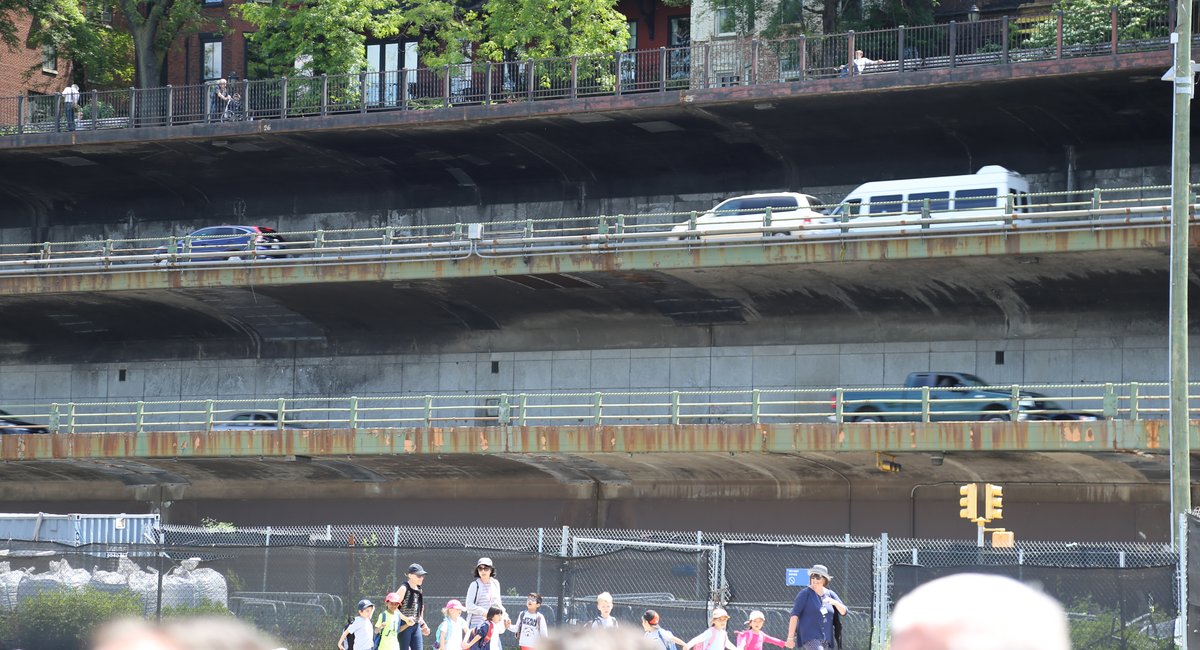This column originally appeared in On The Way, a weekly newsletter covering everything you need to know about NYC-area transportation.
Sign up to get the full version, which includes answers to reader questions, trivia, service changes and more, in your inbox every Thursday.
With a little over two months left in City Hall, Mayor Eric Adams is trying to push through plans for long-overdue repairs to a crumbling section of the Brooklyn-Queens Expressway that local lawmakers said have been hidden from the public.
In a letter to U.S. Transportation Secretary Sean Duffy last week, Adams requested the feds move quickly on approving a rebuild of the highway’s triple-cantilever, two roads stacked and bolted into the side of the hill beneath the Brooklyn Heights promenade.
City engineers have for years warned the steel rebar inside the cantilever’s concrete is corroded, putting the entirety of the more than 70-year-old structure at risk of failure. In the letter, Adams referenced a series of design proposals. A local councilmember said those proposals are news to him, and have been hidden from the public.
Seven years ago, the city transportation department under then-Mayor Bill de Blasio proposed erecting a temporary highway atop the promenade while closing the BQE down for repairs for six years. The plan drew outrage from community boards, who sent city officials back to the drawing board.
But now, Brooklyn Heights leaders fear Adams is trying to tie his successor’s hands by pushing through an unvetted plan that would be just as disruptive to the neighborhood as the temporary highway proposal.
The DOT under Adams proposed three redesigns for the highway in 2022, each of them vague and lacking specific engineering or construction plans. But Hank Gutman, who served as city transportation commissioner during de Blasio’s final year in office, and local City Councilmember Lincoln Restler said Adams submitted 14 proposed redesigns to the federal government that have not been made public.
“They have managed simultaneously to hide the ball and to kick the can down the road,” said Gutman, who now sits on the board of the Brooklyn Bridge Association. “Is this all they have to show for four years and tens of millions in consulting fees?”
Anna Correa, a spokesperson for Adams, confirmed the city, state and feds will present a “broad range of alternatives to the public” that have “been in public discourse” and will include both two- and three-lane configurations of the BQE.
In his letter to Duffy, Adams requested the feds begin environmental review on the proposed redesigns next month and to start soliciting public comments on the plans as soon as late November.
Six Brooklyn elected officials, including Restler, state Assemblymember Jo Anne Simon and U.S. Rep. Nydia Velazquez, sent a letter to Gov. Kathy Hochul asking her to slam the brakes on the project, which also requires state approval.
”We were blindsided by the Adams administration,” Restler told Gothamist. “ They’re planning a public comment period on this critically important project from Thanksgiving to New Year’s, apparently deliberately designed to avoid having to hear from our community and offices.”
Restler has for years called on the DOT to quickly fix the structural problems that threaten the section of the BQE. But now he’s asking Hochul to slow things down, at least until a new mayor takes office next year.
Adams wrote in his letter to Duffy that the city is running out of time to fix the roadway. The triple-cantilever may have to close entirely in the “medium term” without a solution, which would cause a traffic nightmare, Adams wrote.
Over the last five years, the city reduced a lane of the highway in each direction, made some patchwork repairs to fix cracks in its concrete and installed sensors that automatically track and ticket overweight trucks on the roadway. Before those measures were implemented, officials warned the roadway could fail by 2026.
Jon Orcutt, who served as policy director for the transportation department under former Mayor Michael Bloomberg, chalked up the last-minute Hail Mary to an effort by Adams to lock in some “wins” before he leaves office.
“There’s clearly some kind of legacy fever going on over there,” Orcutt said. “They started doing groundbreakings on other projects that won’t be finished for years and years. … I think they’re just trying to get some stamps on some projects, but clearly the next mayor can redirect this in January if they so choose.”
Curious Commuter
Have a question for us? Use this form to submit yours and we may answer it in a future newsletter!
Curious Commuter questions are exclusive for On The Way newsletter subscribers. Sign up for free here.
Question MC in Brooklyn
“Hoping you could do a follow up about the 15-second delay on some emergency exit doors [in subway stations]. I recently encountered one at Fulton Street in the Financial District and can’t believe it’s a thing. It’s obviously so dangerous in case of an emergency! Is the MTA considering expanding this policy or (hopefully) eliminating it?
Answer
MTA Chair Janno Lieber has honed in on the subway emergency gates as “the superhighway of fare evasion.” The agency has in recent years spent big bucks hiring private security guards to stand near some of the gates (though the guards cannot make arrests or issue tickets). The agency has also modified many of the gates across the system so they won’t unlock for 15 seconds after a rider pushes the handle. It’s what the MTA calls “delayed egress.” By the end of the year, the agency expects this to be fully installed at 150 locations “where it is safe to do so.” The MTA believes it’s worth the trouble and says the new initiative is safe. The agency reported in April there’s been a 10% reduction in fare evasion at exit gates with the 15-second delay.

